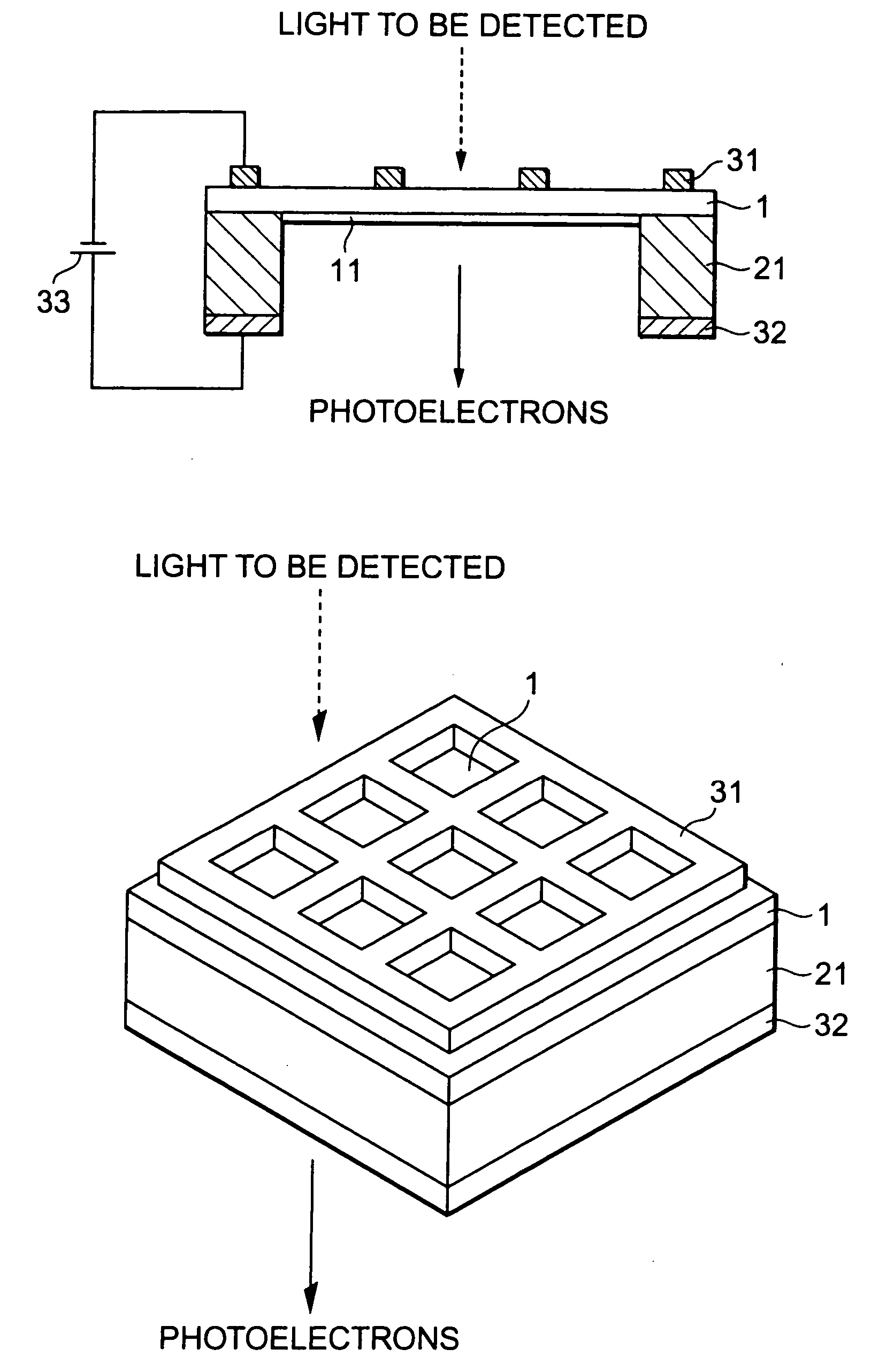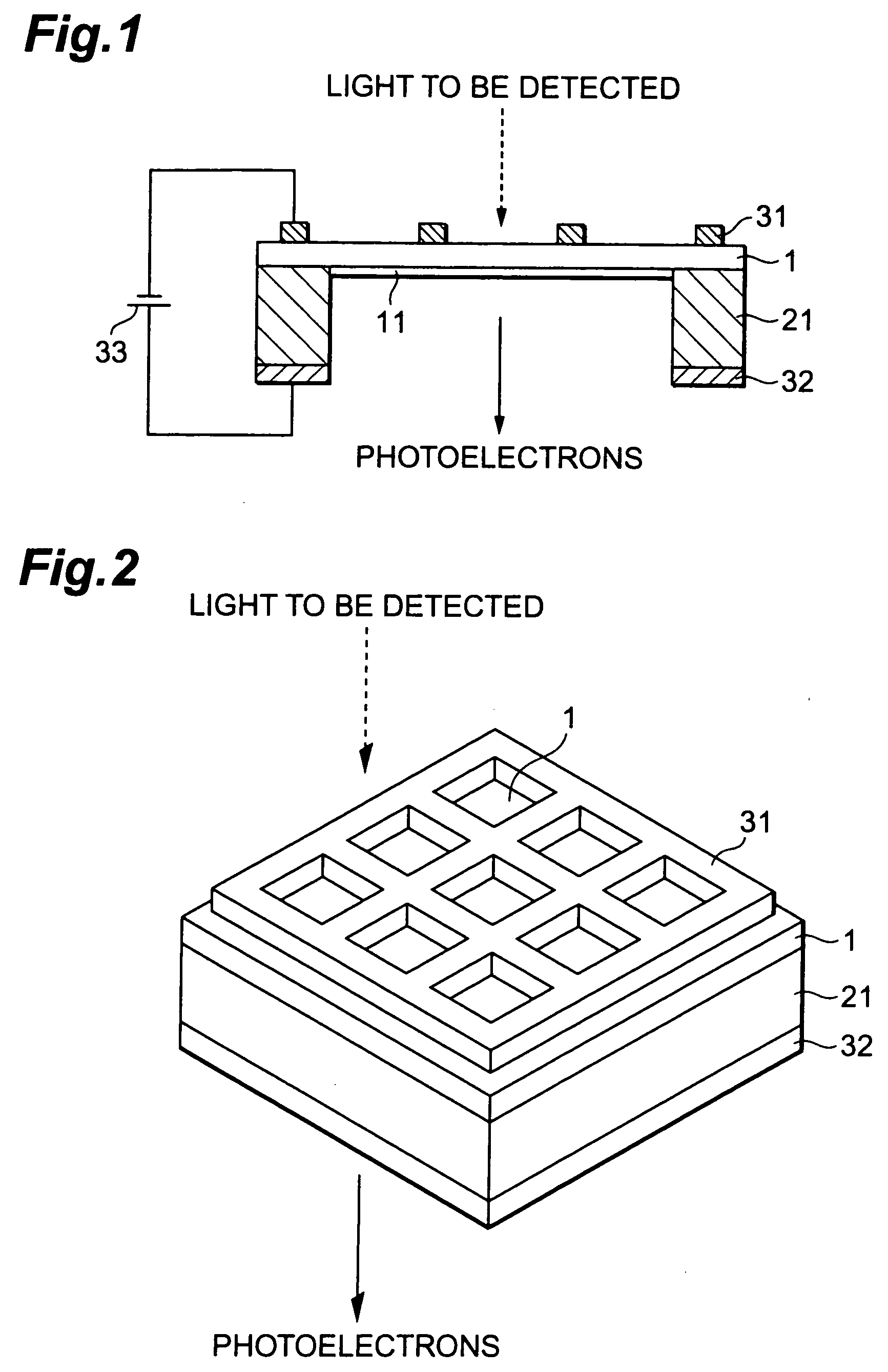Transmission type photoelectric cathode and electron tube
a photoelectric cathode and electron tube technology, applied in the field of transmission-type photoelectric cathodes and electron tubes, can solve the problems of deterioration of the p/n junction or schottky junction thereof, difficulty in realizing a transmission-type photocathode formed of diamonds, and inability to operate stably, so as to achieve a higher brightness and low power consumption
- Summary
- Abstract
- Description
- Claims
- Application Information
AI Technical Summary
Benefits of technology
Problems solved by technology
Method used
Image
Examples
first embodiment
[0032]FIG. 1 is a side and cross-sectional view showing the construction of a transmission type photocathode of the present invention. FIG. 2 is a perspective view showing the transmission type photocathode shown in FIG. 1.
[0033] The transmission type photocathode shown in FIG. 1 comprises a light absorption layer 1, a supporting frame 21, a first electrode 31 and a second electrode 32. In the transmission type photocathode, photoelectrons are excited in the light absorption layer 1 upon incidence of light to be detected such as ultraviolet light or the like, and the photoelectrons thus excited are emitted to the outside. The transmission type photocathode has a transmission type structure that one surface of the light absorption layer 1 (the upper surface of FIG. 1) serves as a plane of incidence to which the light to be detected is made incident and the other surface at the opposite side of the light absorption layer 1 (the lower surface of FIG. 1) serves as a plane of emission fr...
second embodiment
[0056]FIG. 5 is a side and cross-sectional view showing the construction of the transmission type photocathode.
[0057] The transmission type photocathode shown in FIG. 5 comprises a light absorption layer 1, an active layer 11, a supporting frame 21, first electrode film 31a, an auxiliary electrode 34 and a second electrode 32. The constructions of the light absorption layer 1, the active layer 11, the supporting frame 21 and the second electrode 32 are the same as the transmission type photocathode shown in FIG. 1.
[0058] The first electrode film 31a is formed in a thin film form on the plane of incidence of the light absorption layer 1. The first electrode film 31a is formed to be extremely thin (about 30 to 150▭ in thickness). The auxiliary electrode 34 is formed on the first electrode film 31a for electrical connection to the first electrode film 31a formed in a thin film form.
[0059] The transmission type photocathode of this embodiment has the transmission type structure that o...
third embodiment
[0062]FIG. 6 is a side cross-sectional view showing the construction of the transmission type photocathode.
[0063] The transmission type photocathode shown in FIG. 6 comprises a light absorption layer 1, an active layer 11, a supporting frame 22, a first electrode 35 and a second electrode 36. The constructions of the light absorption layer 1 and the active layer 11 out of these elements are the same as the transmission type photocathode shown in FIG. 1.
[0064] The supporting frame 22 serves as supporting means for reinforcing the mechanical strength of the light absorption layer 1 which is formed to be thin. The supporting frame 22 is provided at the outer edge part on the plane of incidence of the light absorption layer 1.
[0065] The first electrode 35 is an incident plane side electrode provided at the plane of incidence of the light absorption layer 1. In this embodiment, the first electrode 35 is formed on the overall surface of the supporting frame 22 at the opposite side to th...
PUM
 Login to View More
Login to View More Abstract
Description
Claims
Application Information
 Login to View More
Login to View More - R&D
- Intellectual Property
- Life Sciences
- Materials
- Tech Scout
- Unparalleled Data Quality
- Higher Quality Content
- 60% Fewer Hallucinations
Browse by: Latest US Patents, China's latest patents, Technical Efficacy Thesaurus, Application Domain, Technology Topic, Popular Technical Reports.
© 2025 PatSnap. All rights reserved.Legal|Privacy policy|Modern Slavery Act Transparency Statement|Sitemap|About US| Contact US: help@patsnap.com



